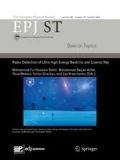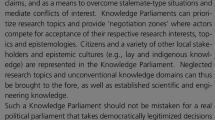Abstract.
The purpose of this White Paper of the EU Support Action “Visioneer” (see www.visioneer.ethz.ch) is to address the following goals:
-
1.
Identify new ways of publishing, evaluating, and reporting scientific progress.
-
2.
Promote ICT solutions to increase the awareness of new emerging trends.
-
3.
Invent tools to enhance Europe’s innovation potential.
-
4.
Develop new strategies to support a sustainable technological development.
-
5.
Lay the foundations for new ways to reach societal benefits and respond to industrial needs using ICT.
Similar content being viewed by others
References
L.C. Bollinger, Announcing the Columbia Committee on Global Thought, http://www.columbia.edu/cu/president/.../051214-committee-global-thought.html
D. Helbing, S. Balietti, From Social Simulation to Integrative System Design. Eur. Phys. J. Special Topics 195, 69 (2011), http://www.visioneer.ethz.ch
L. Leydesdorff, A.A. Akdag Salah, Maps on the basis of the Arts and Humanities Citation Index: the journals Leonardo and Art Journal versus Digital Humanities as a topic JASIST (forthcoming) (2010)
Improving the Peer-Review Process for Grant Applications Reliability, Validity, Bias, and Generalizability (Leiden, 2010)
P.M. Rothwell, C.N. Martyn, Brain 123, 1964 (2000)
S. Thurner, R. Hanel, Peer-review in a world with rational scientists: Toward selection of the average (2010), [E-print: 1008.4324., http://arxiv.org/abs/1008.4324]
D. Helbing, Pluralistic Modeling of Complex Systems, CCSS-10-009 (2010) http://ssrn.com/abstract=1646314(2010)
J.S. Gans, Shepherd G.B., J. Econom. Perspectives 8, 165 (1994), Rejected classic articles by leading economists
B. Whitworth, R. Friedman, First Monday [Online] 14 (2009)
B. Whitworth, R. Friedman, First Monday [Online] 14 (2009)
D.E. Chubin. E.J. Hackett, Peerless science: Peer review and US science policy (State Univ. of New York Pr, 1990)
D. Horrobin, Trends in Pharmacological Sciences 22, 51 (2001), ISSN: 0165-6147, http://www.sciencedirect.com/science/article/B6T1K-4292PVM-1/2/22fd1d9ae541d6eff5101e01e89c9b79
M. Ware, Peer Review: Benefits, Perceptions and Alternatives. Tech. Rep. Mark Ware Consulting (2008), http://www.publishingresearch.net/documents/PRCsummary4Warefinal.pdf
T. Kuhn, The Structure of Scientific Revolutions, 3rd edn. (University Of Chicago Press, 1996)
D.L. Hull, P.D. Tessner, A.M. Diamond, Science 202, 717 (1978), [E-print: http://www.sciencemag.org/cgi/reprint/202/4369/717.pdf. http://www.sciencemag.org/cgi/content/abstract/202/4369/717]
A. Mazlouimian, et al., How citation boosts trigger scientific paradigm shifts (2010) (in preparation)
Journal of Negative Results in Biomedicine, http://www.jnrbm.com/
R. Robinson, On the design and implementation of a market mechanism for peer review and publishing, Tech. rep. NICTA Queensland Research Laboratory
L.I. Meho, The Rise and Rise of Citation Analysis (2006), [E-print: physics/0701012, http://arxiv.org/abs/physics/0701012]
S. Allesina, Accelerating the pace of discovery by changing the peer review algorithm, http://arxiv.org/abs/0911.0344
Science Online, http://www.scienceonlinelondon.org/
S. Rosenbloom, On Facebook, Scholars Link up with Data, http://www.nytimes.com/2007/12/17/style/17facebook.html?_r=1
G. Gugliotta, Wired 17 (2009)
M. Nielsen, Nat. Phys. 5, 238 (2009)
M. Waldrop, Scientific American (2008)
Liquid Pub: Scientific Publications Meet the web, http://liquidpub.org/
OpenAIRE: Open Infrastracture for Research in Europe, http://www.openaire.eu
VISIONEER. Visioneer, Envisioning a Socio-Economic Knowledge Collider (2010), http://www.visioneer.ethz.ch
arXiv.org e-print archive, http://arxiv.org/
Social Science Research Network (SSRN), http://www.ssrn.com/
A. Gentil-Beccot, S. Mele, T. Brooks, Citing and Reading Behaviours in High-Energy Physics, How a Community Stopped Worrying about Journals and Learned to Love Repositories (2009), [E-print: 0906.5418. http://arxiv.org/abs/0906.5418]
P. Davis, Physics papers and the arXiv, Blog entry in The Scholarly Kitchen, (2009). http://scholarlykitchen.sspnet.org/2009/06/17/physics-papers-and-the-arxiv/
R.K. Merton, Science 159, 56 (1968)
J. Lorenz, et al., How social influence undermines the wisdom of crowds (2010) (submitted)
Post-publication Review: Is the Dialog of Science Really a Monologue? http://scholarlykitchen.sspnet.org/2010/09/10/post-publication-revie w-when-the-dialog-of-science-has-become-a-monologue/
P.C. Goetzsche, et al., BMJ 341 (2010), [E-print: http://www.bmj.com/content/341/bmj.c3926.full.pdf, http://www.bmj.com/content/341/bmj.c3926.abstract]
R. Conte, M. Paolucci, Reputation in Artificial Societies: Social Beliefs for Social Order (Kluwer Academic Pub, 2002)
J. Sabater, C. Sierra, Artific. Intell. Rev. 24, 33 (2005)
F.R. Farmer, B. Glass, Building Web Reputation Systems (Oreilly & Associates Inc, 2010)
M. Paolucci, S. Picascia, S. Marmo, Handbook of Research on Web 2.0, 3.0, and X.0 411 (2010)
T. Brabazon, LIBRI-COPENHAGEN- 56, 157 (2006)
F. Grimaldo, M. Paolucci, R. Conte, SSRN eLibrary (2010)
S. Fortunato, Physics Reports 486, 75 (2010) [E-print: 0906.0612]
C. Dellarocas, EC’00: Proceedings of the 2nd ACM conference on Electronic commerce (Minneapolis, Minnesota, United States, ACM, 2000), p. 150
D. Helbing, S. Balietti, From Social Data Mining to Forecasting Socio-Economic Crises. Eur. Phys. J. Special Topics 195, 3 (2011), http://www.visioneer.ethz.ch
Publish or Perish, http://www.harzing.com/pop.htm
Journal Citation Reports: Eigenfactor Metrics, http://admin-apps.isiknowledge.com/JCR/help/h_eigenfact.htm
Journal Citation Reports: Cited Half-life, http://admin-apps.isiknowledge.com/JCR/help/h_ctdhl.htm
J.E. Hirsch, Proc. Nation. Acad. Sci. USA 102, 16569 (2005) [E-print: http://www. pnas.org/content/102/46/16569.full.pdf+html. http://www.pnas.org/content/102/46/16569.abstract]
L. Egghe, Scientometrics 69, 131 (2006)
C.T. Zhang, PLoS ONE 4, e5429+ (2009)
A. Sidiropoulos, D. Katsaros, Y. Manolopoulos, Generalized h-index for Disclosing Latent Facts in Citation Networks (2006), [E-print: cs.DL/0607066. http://arxiv.org/abs/cs.DL/0607066]
B. Jin, ISSI Newsletter 3, 6 (2007)
P.D. Batista, M.G. Campiteli, O. Kinouchi, Scientometrics 68, 179 (2006)
M. Schreiber, New J. Phys. 10, 040201+ (2008)
M.G. Banks, An extension of the Hirsch Index: Indexing Scientific Topics and Compounds (2006) [E-print: physics/0604216. http://arxiv.org/abs/physics/0604216]
E. Garfield, Science 178, 471 (1972), http://view.ncbi.nlm.nih.gov/pubmed/5079701
Isi web of Knowledge, htpp://isiknowledge.com/
H. Small, J. Amer. Soc. Inf. Sci. 24, 265 (1973)
Measuring Impact Where it Matters. http://blogs.plos.org/plos/2009/07/plos-journals-measuring-impact-where-it-matters/
J. Bollen, et al., PLoS ONE 4, e4803 (2009)
J. Priem, B.H. Hemminger, First Monday 15 (2010), http://firstmonday.org/htbin/cgiwrap/bin/ojs/index.php/fm/article/view/2874
F. Radicchi, S. Fortunato, C. Castellano, Proc. Nation. Acad. Sci. 105, 17268 (2008) [E-print: http://www.pnas.org/content/105/45/17268.full.pdf+html. http://www.pnas.org/content/105/45/17268.abstract]
W. Glaenzel, BIBLIOMETRICS AS A RESEARCH FIELD: A course on theory and application of bibliometric indicators (2003), http://www.norslis.net/2004/Bib_Module_KUL.pdf
N. De Bellis, Bibliometrics and Citation Analysis: From the Science Citation Index to Cybermetrics (The Scarecrow Press, Inc., 2009)
Katy Börner Home Page, http://ella.slis.indiana.edu/∼katy/
K. Boerner, A. Scharnhorst, J. Inform. 3, 161 (2009)
Trust Researchers: A Declaration to the Attention of the European Council of Ministers and the Parliament, http://www.trust-researchers.eu/
G. Hardin, Science 162, 1243 (1968)
An introduction to the Neurocommons, http://sciencecommons.org/projects/data
T. Gowers, M. Nielsen, Nature 461, 879 (2009)
G. Wilkins, Web 2.0 Fundamentals, edited by O. Campesatp, K. Nilson Jones (Barlett Publishers, 2010), p. 686
Innocentive: Where the world innovates, http://www2.innocentive.com/
DARPA Network Challenge, https://networkchallenge.darpa.mil/
Google Fixes 10 Bugs in New Chrome Release, http://threatpost.com/en_us/blogs/google-fixes-10-bugs-new-chrome-release-091510
Selected Innovation Prizes and Reward Program, http://keionline.org/content/view/170/1
Website of the Commission on the Measurement of Economic Performance and Social Progress, http://www.stiglitz-sen-fitoussi.fr/
Stiglitz and Sen’s Manifesto on Measuring Economic Performance and Social Progress, http://www.worldchanging.com/archives/010627.html
B. Frey, Happiness: A Revolution in Economics, Vol. 1. MIT Press Books 0262062771 (The MIT Press, 2008), http://ideas.repec.org/b/mtp/titles/0262062771.html
S. Bergheim, Tech. rep. Deutsche Bank Research (2007), http://www.bankresearch.org/economicpolicyblog/2007/05/the_happy_varie.html
E.W. Dunn, L.B. Aknin, M.I. Norton, Science 319, 1687 (2008) [E-print: http://www.sciencemag.org/cgi/reprint/319/5870/1687.pdf; http://www.sciencemag.org/cgi/content/abstract/319/5870/1687]
P. Ball, Nature (2010), http://www.nature.com/news/2010/100906/full/news.2010.447.html
Bank of happiness, http://www.onnepank.ee
Doo good, http://www.doo-good.org/
A.P. Fiske, Structures of Social Life: The Four Elementary Forms of Human Relations: Communal Sharing, Authority Ranking, Equality Matching, Market Pricing (Free Press, 1991)
E. Clary, et al., Understanding and assessing the motivations of volunteers: A functional approach (1998), http://ucspace.canberra.edu.au/display/7125/Volunteerism
D. Tapscott, A.D. Williams, Wikinomics: How Mass Collaboration Changes Everything (Portfolio Hardcover, 2006)
Sciencecommons promotion video, http://www.sciencecommons.org/about/science-commons-dylan-video/
U. Gneezy, A. Rustichini, in Advances in Behavioral Economics (The Roundtable Series in Behavioral Economics), edited by C.F. Camerer (Princeton University Press, 2003)
D. Helbing, S. Balietti, Fundamental and real world challenges in economics (in print), (2010)
D. Helbing (ed.), Managing Complexity: Insights, Concepts, Applications, 1st edn. (Springer, 2007), http://www.worldcat.org/isbn/3540752609
IRGC: International Risk Governance Council, http://www.irgc.org/
K. Kelly, Edge 179 (2006), http://www.edge.org/3rd_culture/kelly06/kelly06_index.html
Author information
Authors and Affiliations
Corresponding author
Rights and permissions
About this article
Cite this article
Helbing, D., Balietti, S. How to create an innovation accelerator. Eur. Phys. J. Spec. Top. 195, 101–136 (2011). https://doi.org/10.1140/epjst/e2011-01403-6
Received:
Revised:
Published:
Issue Date:
DOI: https://doi.org/10.1140/epjst/e2011-01403-6




